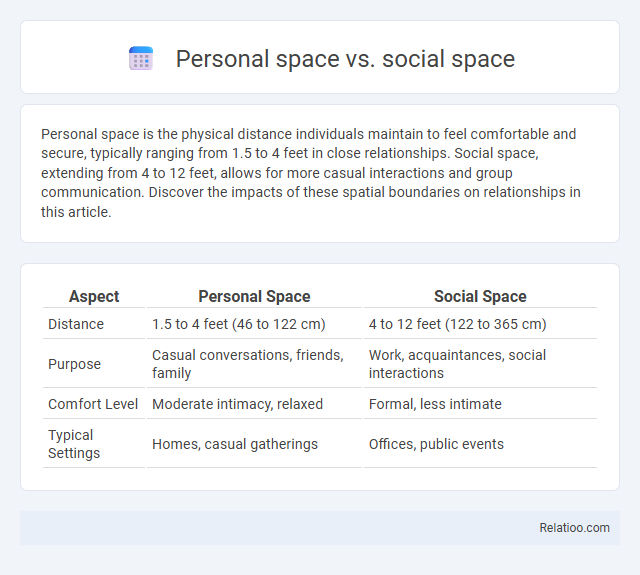Personal space is the physical distance individuals maintain to feel comfortable and secure, typically ranging from 1.5 to 4 feet in close relationships. Social space, extending from 4 to 12 feet, allows for more casual interactions and group communication. Discover the impacts of these spatial boundaries on relationships in this article.
Table of Comparison
| Aspect | Personal Space | Social Space |
|---|---|---|
| Distance | 1.5 to 4 feet (46 to 122 cm) | 4 to 12 feet (122 to 365 cm) |
| Purpose | Casual conversations, friends, family | Work, acquaintances, social interactions |
| Comfort Level | Moderate intimacy, relaxed | Formal, less intimate |
| Typical Settings | Homes, casual gatherings | Offices, public events |
Understanding Personal Space: Definition and Importance
Personal space refers to the immediate physical area surrounding an individual, typically extending about 18 inches to 4 feet, where intrusion often causes discomfort. Social space ranges from 4 to 12 feet, used for interactions with acquaintances and friends, allowing comfortable communication without feeling overwhelmed. Understanding your personal space is crucial for maintaining respectful and effective social interactions, preventing misunderstandings, and enhancing personal comfort in various environments.
Defining Social Space: Boundaries and Functions
Social space defines the physical distance maintained during casual interactions, typically ranging from 4 to 12 feet, balancing comfort and engagement in social settings. Boundaries of social space function to respect individuals' privacy while enabling effective communication within groups or public environments. Understanding these limits allows your interactions to remain respectful and context-appropriate, enhancing social dynamics and connection.
Key Differences Between Personal and Social Space
Personal space refers to the immediate area surrounding an individual, typically extending 18 to 24 inches, where physical and emotional comfort is maintained. Social space spans a larger area, ranging from 4 to 12 feet, used for casual conversations and social interactions with acquaintances or colleagues. Key differences between personal and social space include the distance maintained, the nature of relationships involved, and the context of interaction, with personal space being more intimate and protective while social space supports more formal or group engagements.
Cultural Influences on Spatial Behavior
Cultural influences on spatial behavior shape how individuals perceive and maintain personal, social, and public spaces, with variations evident across different societies. In high-context cultures like Japan, closer distances are acceptable in social and personal interactions, reflecting strong community ties, whereas low-context cultures such as the United States prioritize larger personal and social spaces to emphasize individualism. These cultural distinctions affect communication patterns, comfort levels, and interpersonal dynamics, underscoring the importance of understanding spatial preferences in multicultural environments.
Psychological Effects of Personal Space Violations
Psychological effects of personal space violations include increased stress, anxiety, and discomfort, often triggering a fight-or-flight response due to perceived threats. Personal space, typically ranging from 18 inches to 4 feet, serves as a crucial buffer zone for emotional safety, while social space, extending from 4 to 12 feet, is more flexible and used for casual or professional interactions. Breaching personal space can lead to feelings of vulnerability, decreased trust, and impaired communication, making respect for these zones essential in both personal and social contexts.
The Role of Social Space in Group Dynamics
Social space plays a critical role in group dynamics by facilitating interaction, communication, and collaboration among members. It defines the physical and psychological zones where individuals engage collectively, influencing group cohesion and productivity. Understanding social space allows leaders to optimize group settings, balancing proximity to enhance cooperation while respecting personal space boundaries.
Navigating Personal Space in Public Settings
Navigating personal space in public settings requires understanding the distinctions between personal space (18 inches to 4 feet), social space (4 to 12 feet), and intimate space (less than 18 inches). Your awareness of these zones helps maintain comfort and respect, especially in crowded environments where boundaries can easily be crossed. Mastering this balance enhances social interactions and reduces discomfort in diverse public scenarios.
Technology’s Impact on Social and Personal Space
Technology significantly reshapes personal and social spaces by altering communication patterns and physical interactions, with digital platforms expanding social space beyond traditional boundaries and enabling constant connectivity. Virtual environments create new dimensions of personal space, where individuals control their privacy and exposure differently compared to face-to-face settings. The pervasive use of mobile devices and social media challenges conventional concepts of personal space, blending real and virtual experiences while influencing social norms and interpersonal boundaries.
Strategies for Respecting Boundaries in Various Contexts
Respecting boundaries involves recognizing the differences between personal, social, and public spaces, with personal space typically ranging from 1.5 to 4 feet, social space from 4 to 12 feet, and public space extending beyond 12 feet. Effective strategies include observing nonverbal cues, such as body language and eye contact, to gauge comfort levels, and adjusting proximity accordingly during interactions in professional, social, or public settings. Tailoring communication and physical distance based on cultural norms and individual preferences fosters respect and reduces discomfort in diverse environments.
Enhancing Communication Through Spatial Awareness
Enhancing communication through spatial awareness involves understanding the distinctions between personal space, social space, and intimate space to foster more effective interactions. Personal space typically ranges from 1.5 to 4 feet and is considered the comfort zone for casual conversations, while social space extends from 4 to 12 feet, suitable for professional and group interactions. Recognizing these spatial boundaries helps reduce discomfort, promotes mutual respect, and improves the clarity and receptiveness of verbal and nonverbal communication cues.

Infographic: Personal space vs Social space
 relatioo.com
relatioo.com